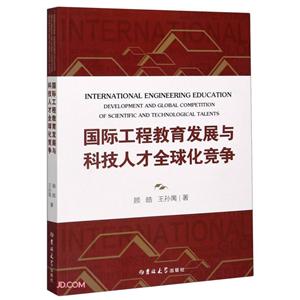扫一扫
关注中图网
官方微博
¥20.9(3.6折)?
预估到手价是按参与促销活动、以最优惠的购买方案计算出的价格(不含优惠券部分),仅供参考,未必等同于实际到手价。
本类五星书更多>
-
>
心灵元气社
-
>
县中的孩子 中国县域教育生态
-
>
(精)人类的明天(八品)
-
>
厌女(增订本)
-
>
这样学习才高效/杨慧琴
-
>
心理学经典文丛:女性心理学
-
>
中国文化5000年
买过本商品的人还买了
国际工程教育发展与科技人才全球化竞争 版权信息
- ISBN:9787569272925
- 条形码:9787569272925 ; 978-7-5692-7292-5
- 装帧:暂无
- 册数:暂无
- 重量:暂无
- 所属分类:>>
国际工程教育发展与科技人才全球化竞争 内容简介
本书旨在通过整合对全球创新、知识转移、流动性和政府相关政策的分析, 扩展各国对全球人力资源在科学和技术 (HRST) 流动性维度的理解。该书借鉴了非常有价值的评价和清单、分析文献以及OECD成员国和其他观察国的*新统计数据, 以解释全球人力资源在科学和技术流动中的政策影响、层面和意义。
国际工程教育发展与科技人才全球化竞争 目录
Chapter 1: Engineering Technology Education in the United States
1.1 Introduction
1.2 Engineering technology education in the U. S. (Instructions, programs, and accreditation)
1.3 The nature of engineering technology education
1.4 Engineering technology education supply and demand
1.5 Licensing,certification and equivalency
1.6 Recommendations
Chapter 2: The Production of Engineering Technology Talents in the United States
2.1 Introduction
2.2 Trends in degree production
2.3 Educational composition of the engineering technology workforce
2.4 Demographics: diversity
2.5 Work-based education and training
2.6 Community college experiences and connections to pre K-12 education
Chapter 3: The Employment of Engineering Technology Talents in the OECD Countries
3.1 Introduction
3.2 Size and composition of the engineering technology work force
3.3 Trends in employment,income,and age
3.4 Work rules, skills, and job performance
3.5 Career pathways and hiring patterns
3.6 Shortages
3.7 The impact of automation and technological development
Chapter 4: The Global Competition for Engineering Technology Talents-Discussion on the OECD Countries' Labor Market
4.1 Knowledge diffusion and impacts of international mobility
4.2 International mobility and its impact
4.3 Mobility strategies and current policy approaches
4.4 Suggestion for government intervention and future mobility policy suggestion
Chapter 5: The Significant Relationships between Culture, Physical Environment, Geographical Location, and the Success of Technology Transfer: A Case Study and OECD Countries Private Manufacturing Industries
5.1 Introduction
5.2 Cultural factors
5.3 Cross-cultural theories
5.4 Leadership and culture
5.5 Case study:A private Chinese firm-Huawei
5.6 Discussion on OECD countries private manufacturing industries
5.7 Conclusion
Chapter 6: Analysis on Engineering Technology Education in the United States and Other OECD Countries
6.1 Introduction
6.2 Present situation and characteristics of engineering technology education in the United States and other OECD countries
6.3 Strategies for science, technology, engineering and math in engineering technology education
6.4 The impact of engineering technology education on regional industrial competitiveness
6.5 Future development of engineering technology education in the United States and other OECD countries
6.6 Findings and conclusions
References
1.1 Introduction
1.2 Engineering technology education in the U. S. (Instructions, programs, and accreditation)
1.3 The nature of engineering technology education
1.4 Engineering technology education supply and demand
1.5 Licensing,certification and equivalency
1.6 Recommendations
Chapter 2: The Production of Engineering Technology Talents in the United States
2.1 Introduction
2.2 Trends in degree production
2.3 Educational composition of the engineering technology workforce
2.4 Demographics: diversity
2.5 Work-based education and training
2.6 Community college experiences and connections to pre K-12 education
Chapter 3: The Employment of Engineering Technology Talents in the OECD Countries
3.1 Introduction
3.2 Size and composition of the engineering technology work force
3.3 Trends in employment,income,and age
3.4 Work rules, skills, and job performance
3.5 Career pathways and hiring patterns
3.6 Shortages
3.7 The impact of automation and technological development
Chapter 4: The Global Competition for Engineering Technology Talents-Discussion on the OECD Countries' Labor Market
4.1 Knowledge diffusion and impacts of international mobility
4.2 International mobility and its impact
4.3 Mobility strategies and current policy approaches
4.4 Suggestion for government intervention and future mobility policy suggestion
Chapter 5: The Significant Relationships between Culture, Physical Environment, Geographical Location, and the Success of Technology Transfer: A Case Study and OECD Countries Private Manufacturing Industries
5.1 Introduction
5.2 Cultural factors
5.3 Cross-cultural theories
5.4 Leadership and culture
5.5 Case study:A private Chinese firm-Huawei
5.6 Discussion on OECD countries private manufacturing industries
5.7 Conclusion
Chapter 6: Analysis on Engineering Technology Education in the United States and Other OECD Countries
6.1 Introduction
6.2 Present situation and characteristics of engineering technology education in the United States and other OECD countries
6.3 Strategies for science, technology, engineering and math in engineering technology education
6.4 The impact of engineering technology education on regional industrial competitiveness
6.5 Future development of engineering technology education in the United States and other OECD countries
6.6 Findings and conclusions
References
展开全部
国际工程教育发展与科技人才全球化竞争 作者简介
王孙禺,清华大学教授,博士生导师,联合国教科文组织国际工程教育中心副主任兼秘书长,中国工程教育认证协会常务理事,中国高等工程教育专业委员会理事,清华大学教育研究所原所长,清华大学人文社会科学学院原院务委员会主任。
书友推荐
- >
我从未如此眷恋人间
我从未如此眷恋人间
¥32.4¥49.8 - >
李白与唐代文化
李白与唐代文化
¥8.9¥29.8 - >
月亮虎
月亮虎
¥14.4¥48.0 - >
龙榆生:词曲概论/大家小书
龙榆生:词曲概论/大家小书
¥13.0¥24.0 - >
月亮与六便士
月亮与六便士
¥15.1¥42.0 - >
苦雨斋序跋文-周作人自编集
苦雨斋序跋文-周作人自编集
¥6.9¥16.0 - >
上帝之肋:男人的真实旅程
上帝之肋:男人的真实旅程
¥19.3¥35.0 - >
二体千字文
二体千字文
¥14.0¥40.0




















